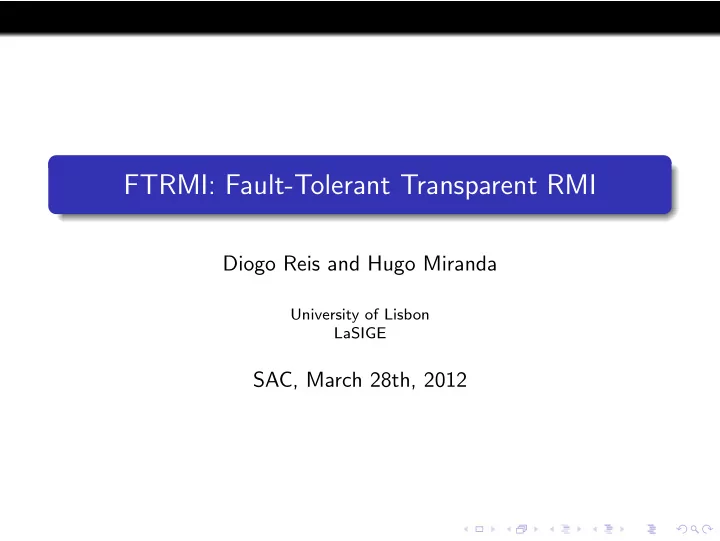

FTRMI: Fault-Tolerant Transparent RMI Diogo Reis and Hugo Miranda University of Lisbon LaSIGE SAC, March 28th, 2012
Remote Procedure Calls What? A simple approach for distributed computing Hides the network from the application (client and server) programmer Server side Client side int f(int y) { // Do something // Do something x=f(y); return z; // Do more }
Remote Procedure Calls Who? Implementation examples Procedural ONC (SUN) RPCs, Web Services OO CORBA, JRMI
Remote Procedure Calls How? JRMI as an example
The Availability Limitation of RPC’s What if server fails? Server name is well-known Stubs cannot reroute remote calls to alternative servers Server state would not be available at the replica
Approaches for State-full Consistent Replication of Servers Middleware Aware Client and server stacks cooperate to support replication Disadvantages Clients and servers use non-standard protocol Must run special version of the middleware Examples Jgroup/ARM Filterfresh FT-CORBA . . .
Approaches for State-full Consistent Replication of Servers Middleware Unaware Replication is hidden from the application and the middleware “Proxies” capture and (possibly) interpret the client/server traffic Disadvantages Respecting the protocols raises limitations on the operations that can be provided Examples Aroma Snoops traffic at client and server side FTRMI
Fault-Tolerant RMI (FTRMI) Overview Proxy placed on the server side Between the standard library class and server skeleton Class with the same name and API of the original JRMI sun.rmi.server.UnicastServerRef -Xbootclasspath/p No code change at the client or server
FTRMI Process
FTRMI Implementation Incoming calls Intercept remote calls before they are delivered to the server Use Linux libcap to retrieve call’s TCP/IP connection information Sequence and Ack number IP origin and destination addresses Deliver the call and TCP data to the Appia Group Communication Service Appia enforces the atomic broadcast properties
FTRMI Implementation Calls received from clients
FTRMI Implementation Calls received from Appia Forward the call to skeleton Intercept the reply Prepare a TCP segment that matches the TCP expected reply at the client Send the TCP segment Using raw sockets
FTRMI Implementation Handling calls received from Appia
FTRMI Implementation Client Transparency Client’s TCP will receive multiple copies of the reply Consider all but the first as duplicates Discard
FTRMI Implementation Multiple reply handling at the clients
Fault Tolerance Appia protocols Provide atomic broadcast Support for a distributed state machine Support for state synchronisation when servers recover TCP Duplicate detection Case where server that received the request fails
Evaluation Performance FTRMI experimented with 3 distinct total order protocols provided by Appia FTRMI-1 Regular, Coordinator-based Total Order FTRMI-2 Regular, Causal Order-based Total Order FTRMI-U Uniform Total Order And compared with 2 approaches JRMI Off-the-shelf, not replicated JRMI Jgroup/ARM middleware-aware framework Clients and servers share a GCS Remote procedure int procedure(String s)
Evaluation Latency 22 JRMI 20 FTRMI-1 FTRMI-2 18 FTRMI-U Jgroup/ARM 16 average time (ms) 14 12 10 8 6 4 2 0 s=2 c=2 s=2 c=4 s=3 c=3 s=3 c=6 s=4 c=4 s=4 c=8 s - servers, c - clients arguments size: 2000 bytes
Performance Results Summary JRMI always presents the best performance results FTRMI scales well Server-Server 4 × –10 × more than Client-Server traffic Some protocols don’t have a linear relation between latency and traffic
Conclusions & Future Work FTRMI Transparent replication of JRMI servers without code changes at the client or the server No need to use specialised libraries at the client side Encouraging performance results Future Work Extend fault tolerance to the JRMI Registry Experiment this approach in other RPC frameworks
Recommend
More recommend